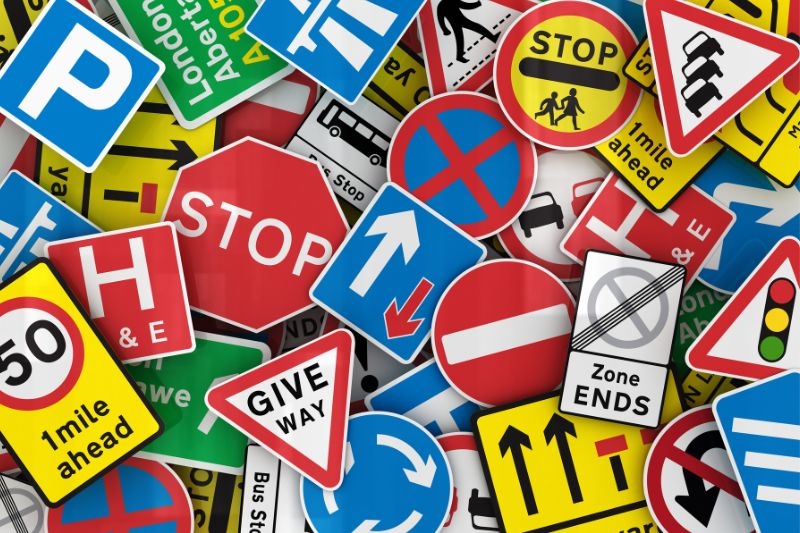Driving is a privilege that comes with great responsibility. In this guide, We will take you through the essential driving rules in the UK, providing you with the knowledge you need to navigate the roads confidently and responsibly.
The importance of knowing and following driving rules
Driving rules exist for a reason – to maintain order and protect everyone on the road. By knowing and following these rules, you contribute to a safer driving environment for yourself and others. It is essential to familiarize yourself with the Highway Code, a comprehensive guide that outlines the rules and best practices for driving in the UK. By adhering to these guidelines, you demonstrate your commitment to responsible driving and reduce the risk of accidents.
Understanding road signs and markings
Road signs and markings play a critical role in guiding drivers and providing important information. It is vital to understand the various types of road signs and markings to interpret them correctly while driving. Road signs are divided into several categories, including regulatory signs, warning signs, and informational signs. Each category has its own set of symbols and colours that convey specific instructions or warnings to drivers. Additionally, road markings such as lines, arrows, and symbols provide valuable guidance for lane usage, parking restrictions, and pedestrian crossings. Familiarize yourself with the different road signs and markings to ensure you can navigate the roads safely and effectively.
Speed limits and their significance
Speed limits are in place to control the flow of traffic and reduce the risk of accidents. It is essential to adhere to the designated speed limits on different types of roads. In the UK, speed limits are typically indicated by road signs, but there are also default limits that apply in the absence of specific signage. For example, in built-up areas, the default speed limit is 30 miles per hour, unless otherwise stated. On single carriageway roads, the limit is 60 miles per hour, and on dual carriageways and motorways, it is 70 miles per hour. It is crucial to obey these limits to ensure your safety and the safety of others on the road.
Rules for intersection and roundabout usage
Intersections and roundabouts can be challenging to navigate, especially during peak traffic hours. Familiarizing yourself with the rules for intersection and roundabout usage will help you navigate these situations safely and efficiently. When approaching an intersection, always give way to vehicles on the right, unless otherwise indicated. At roundabouts, yield to traffic already on the roundabout and enter only when it is safe to do so. Remember to signal your intentions clearly to communicate with other drivers and always be aware of pedestrians and cyclists.
Overtaking and lane discipline
Overtaking is a maneuver that should be executed with caution and consideration for other road users. In the UK, you are allowed to overtake on the right-hand side, but only when it is safe and legal to do so. Before overtaking, ensure that the road ahead is clear, and use your indicators to signal your intentions to other drivers. Maintain a safe distance from the vehicle in front of you and return to your lane once you have completed the maneuver. Additionally, practicing good lane discipline is essential for a smooth and safe driving experience. Keep to the left unless overtaking, and use the appropriate lanes for turning or merging.
Parking rules and regulations
Parking regulations in the UK are designed to maximize road safety and ensure the efficient use of limited parking spaces. Familiarize yourself with the various parking restrictions to avoid fines and penalties. Always park in designated areas and follow any signage or markings indicating time limits or restrictions. It is crucial to be aware of parking zones, such as residential parking zones or pay and display areas, where different rules may apply. When parking, ensure that you leave enough space for other vehicles and do not obstruct driveways or pedestrian access.
Driving under adverse weather conditions
The UK is known for its unpredictable weather, and driving under adverse conditions requires extra caution and preparation. Rain, fog, snow, and ice can significantly impact road conditions and increase the risk of accidents. When driving in adverse weather, reduce your speed and increase your following distance to allow for longer braking distances. Use your headlights to improve visibility and be aware of slippery surfaces. It is also essential to check weather forecasts before setting off on a journey and consider whether the conditions are suitable for driving.
Tips for defensive driving in the UK
Defensive driving is a technique that focuses on anticipating and avoiding potential hazards on the road. By adopting a defensive driving mindset, you can greatly reduce the risk of accidents and ensure your safety. Always be alert and aware of your surroundings, constantly scanning for potential dangers. Maintain a safe following distance from the vehicle in front of you and adjust your speed to match the road conditions. Avoid distractions, such as mobile phones or loud music, as they can impair your concentration. Lastly, anticipate the actions of other drivers and be prepared to react accordingly.
The consequences of breaking driving rules
Breaking driving rules can have severe consequences, both legal and personal. In the UK, traffic offenses are penalized with fines, penalty points on your driving license, and sometimes even disqualification from driving. Additionally, breaking driving rules can lead to accidents, injuries, and loss of life. It is crucial to understand the potential consequences of reckless driving and prioritize the safety of yourself and others on the road.
Resources for learning and practicing driving rules
Learning and practicing driving rules is an ongoing process that requires dedication and effort. Fortunately, there are numerous resources available to help you improve your knowledge and skills. The Highway Code, mentioned earlier, is a valuable resource that provides comprehensive information on driving rules and best practices. Additionally, there are online tutorials, driving schools, and practical driving tests that can help you refine your understanding and abilities. Take advantage of these resources to enhance your driving skills and become a responsible, confident driver.
Conclusion
Mastering the road in the UK requires a thorough understanding of driving rules and a commitment to responsible driving. By familiarizing yourself with road signs, adhering to speed limits, and practicing good lane discipline, you can navigate the roads safely and efficiently. Remember to always drive defensively, especially under adverse weather conditions, and be aware of the potential consequences of breaking driving rules. By continuously learning and practicing, you can develop the skills necessary to become a skilled and responsible driver on UK roads. Stay safe, obey the rules, and enjoy the journey!





